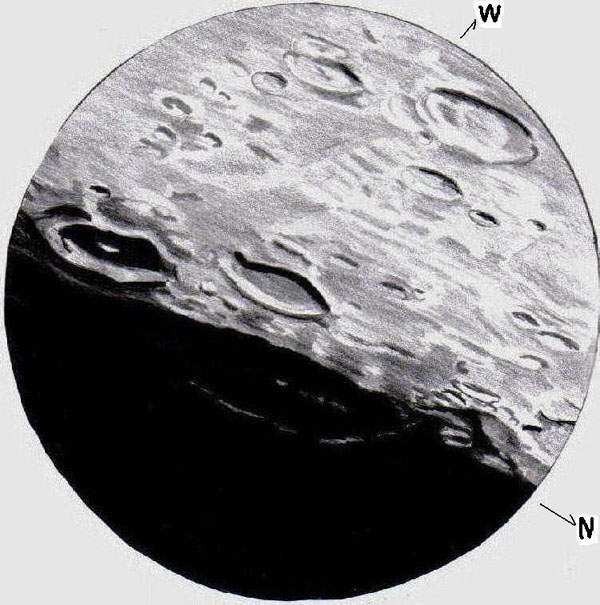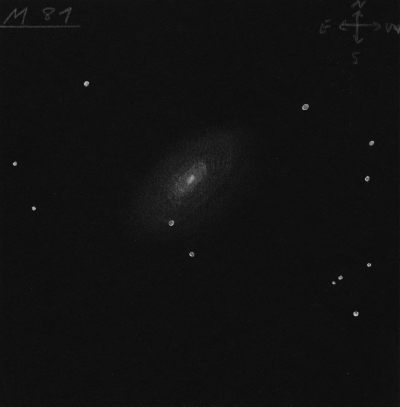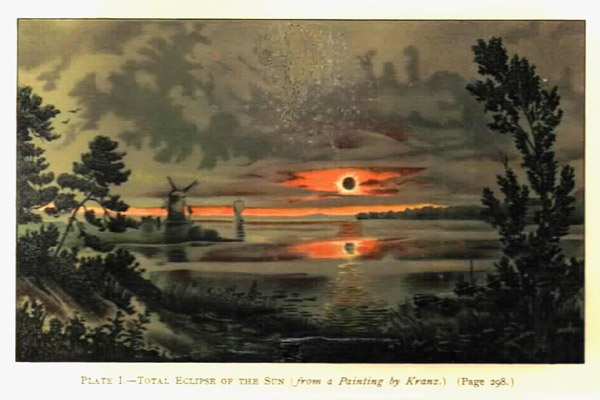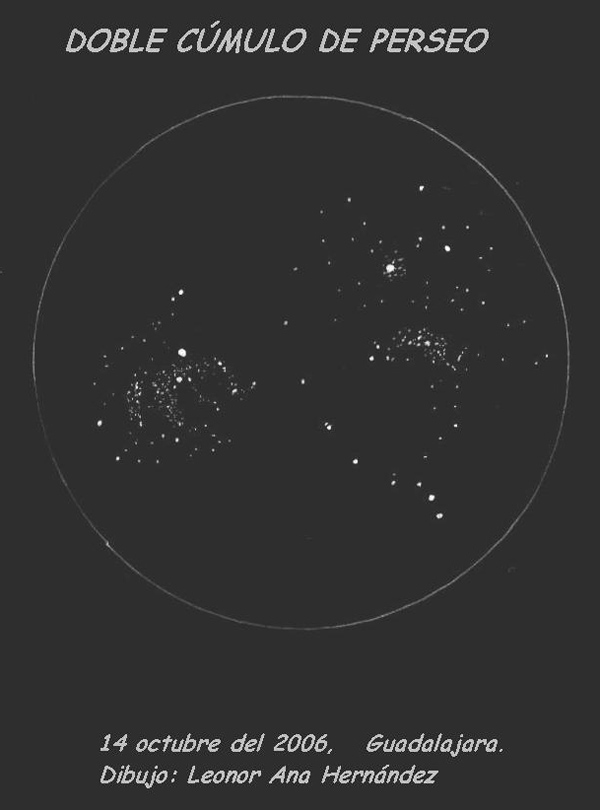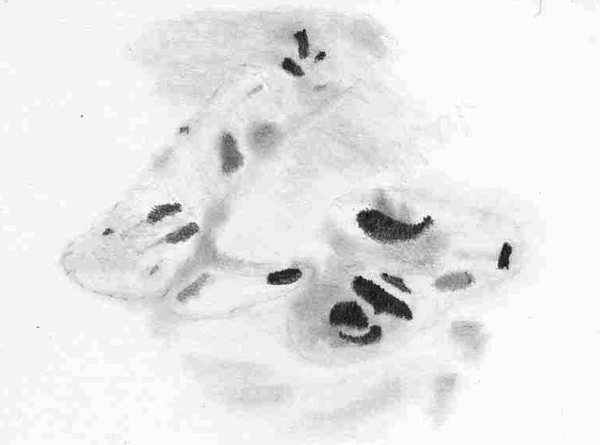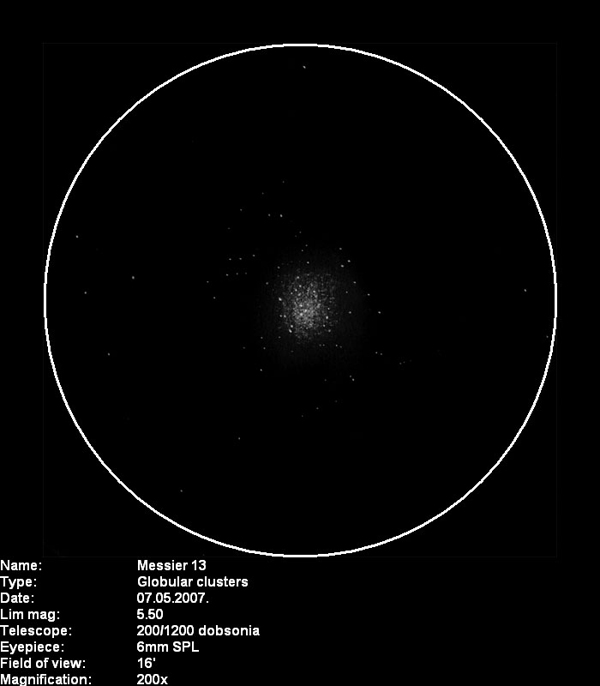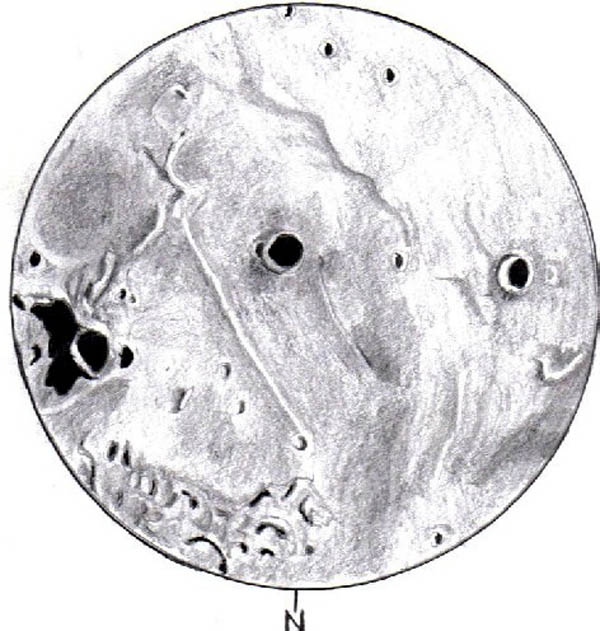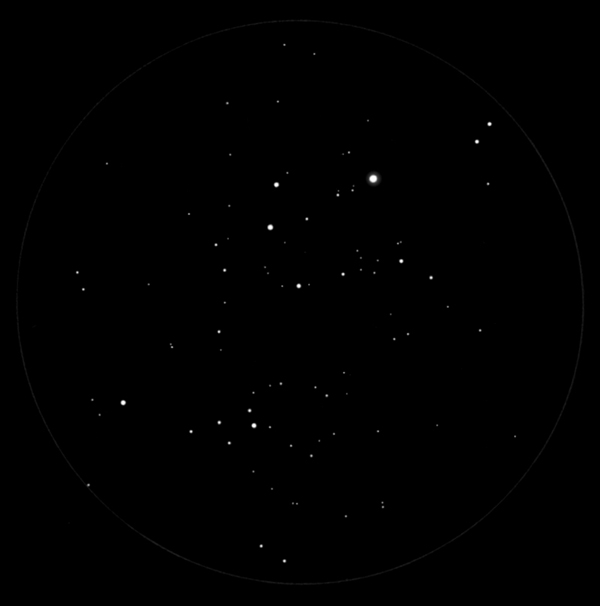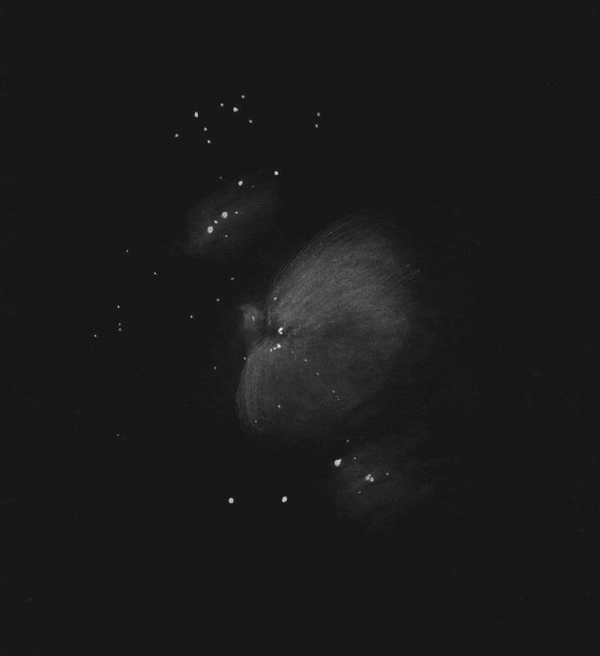At one day past full moon old luna was arching it’s way to the high point for the
night when I selected for my sketching target craters along the terminator on the
eastern side of the moon. Six craters larger than 45 kilometers in diameter are
included in this sketch. With only the highest points along the western rim being
touched by sun rays, it is sundown at crater Gauss. With Gauss measuring 177 km.
in diameter it is categorized as a walled plain crater and dates back to the
Nectarian age (3.9-3.8 billion years ago). Southwest of Gauss with the floor in
darkness except for the illuminated central peak we have crater Hahn, a formation
slightly younger than Gauss and smaller at 84 km. To the north of Hahn is a crater
of the same age as Gauss known as Berosus. It measures 77 km in diameter and its
western wall is not as high as that of its partner Hahn. The largest crater on the
western side of the sketch is Geminus at 86 km. It has a low central peak and no
crater rays, although it is the youngest of the craters in the sketch at about 2 billion
years of age. The smaller crater close to Geminus to the east is 47 km. crater
Bernoulli. And finally to the south of Geminus is crater Burckhardt at 57 km. in
diameter with small craters straddling it to the southeast and southwest.
Sketching: Graphite 2H pencils and India ink on
White 8.5”x11” copy paper
Telescope: 10” f/5.7 Dobsonian 6mm eyepiece
Time: 10-8-2006, 5:30-6:30 UT
Colongitude: 101.6°
Weather: clear, calm
Seeing : Antoniadi III
Frank McCabe
A Trip Down Memory Lane
As with all Galaxies, looking at Messier 81 is another trip down the
collective memory lane of the Universe. Twelve million years – that’s
the age of the light reaching us from Bode’s Galaxy and by cosmical
standards that’s not even really old.
Just like M 82, its edge-on partner galaxy, M 81 is well worth a closer
look, even though the number of visible detail is by far smaller than in
M 82.
What you can actually see is a bright core and a diffuse halo, quickly
dropping of in brightness from the center to the edges and with only
undefined detail visible.
Still Bode’s Galaxy belongs to the brightest and most fascinating
objects of its kind, a must-see for any astronomer out there in search
of a good view.
Date: April 12, 2007
Location: Kegelhaus, Erbendorf, Bavaria, Germany
Instrument: Dobsonian 8″ f/6
Constellation: Ursa major
Seeing: II of VI
Transparency: II of VI
NELM: 6m0
Magnification: 133x
Sebastian Lehner
“Himmel und erde”
Total Solar Eclipse 19th Century
This is a painting in David P. Todd’s, A New Astronomy © 1897, American Book
Company by the 19th century German painter W. Kranz. Unfortunately this beautiful
plate is water damaged top center in my copy of the textbook. The author retrieved
this plate from “Himmel und erde” edited by Dr. Schwahn. Another painting by Kranz
can be found at the LPOD website May 29, 2006. The image on LPOD is a poorly
scanned copy. I have seen a number of Kranz’s drawings and paintings and I tend to
think of him as a19th century forerunner to the great 20th century artist, Chesley
Bonestell.
David P. Todd writes this on pages 297-298 about W. Kranz’s painting in the
frontispiece:
“…Total eclipses occurring near the middle of the year are longest, if at the same
time the moon is near perigee, and their paths fall within the tropics. Always
after total eclipse is over, the partial phase begins again, growing smaller and
smaller and the sun getting continually brighter, until last contact when full
sunlight has returned.… If the atmosphere is saturated with aqueous vapor, weird
color effects ensue, by no means overdrawn in the frontispiece.”
Frank McCabe
Pair of Cherries
The object is “h x Perseii” the double cluster in Persei, through the
telescope it seems to be a pair of cherries hanging on a little tail.
The telescope is a Meade 8″ and observing through a Swan ocular 36 mm
with a big field of vision. I made it with a pencil on a white paper but with some
problems, because the night was very bad, almost covered by clouds moving very
fast, that covered the image through the telescope. It was very hard to sketch in these
conditions, but I was enjoying it very much. This is the original hand made with and
later changed to negative with the computer.
The date: 14 October 2006 in Guadalajara, Spain.
Regards.
Leonor
Magnetic markers
Living in the UK one has to embrace every opportunity to get the pencils out and
enjoy a little astro sketching as breaks in the cloud cover can be frustratingly
infrequent.
For me this includes capturing Sun spots in white light when the sun shines and
I’m close to my observatory with a few quiet minutes to spare.
I caught the complex Sun Spot group 956 during the afternoon of Saturday 19th May
as it transited the meridian.
Antares 105mm F15 Achromatic refractor
Baader solar film white light filter
Denk binoviewer with Celestron Axiom 23mm eyepieces
Magnification of 163X
Cartridge paper, HB Derwent pencil & blending stump.
Image scanned and mirror flipped.
Dale Holt, Hertfordshire, UK
Globe of suns
7th May 2007. around 20:30UT
Novo Cice, Croatia
This sketch was created on plain A4 paper using graphite pencils and
fingers (for blurring). Later it was scanned and inverted in Photoshop
after some minor contrast and brightness adjustments.
I used 8″ F6 Dobson and 6mm Super Plossl Eyepiece. Magnification was
200x and field of view was 0.25°. Limiting magnitude was 5.50 and
transparency was very good.
M13 is beautiful globular cluster in Hercules. With an apparent
magnitude of 5.8, it is barely visible with the naked eye on a very
clear night. Its real diameter is about 145 light-years, and is composed
of several hundred thousand stars, the brightest of which has an
apparent magnitude of 11.95. M13 is 25,100 light-years away from Earth.
Vedran Vrhovac
www.inet.hr/~vevrhova/english/index.htm
The Ever Popular Rupes Recta
In the morning hours before sun-up the early waning crescent moon was superimposed
on the firmament just west of the Pleiades. I was somewhat transfixed by this
scene but I was set up to sketch “straight wall” on the floor of the lunar Sea of
Clouds. From the eastern edge of Mare Nubium you can see the Triplet craters
Thebit (57 km), A and L. Next moving westward is the Imbrian escarpment Rupes
Recta , not a true wall in the usual sense but on one side standing more than 300
meters high at some points and 114 km in length. The scarp face would be visible
from crater Birt (17 km) to the west, the youngest of the larger craters sketched
here. Touching the rim of Birt to the east is Birt A. Continuing westward we see
Rima Birt a 51 km rille from the Imbriam epoch. At the end of the rille to the
south, is tiny 3 km crater Birt F seen in this sketch. Finally sitting on a
wrinkle in the floor of the mare is crater Nicollet (15 km) a Eratosthenian epoch
impact scar.
Sketching:
For this sketch I used: white copy paper, graphite pencil and pen and ink
Contrast adjusted with Imageenhance software
Telesccope: 18 inch f/ 5 Dobsonian working at 222X (9mm ocular)
Date: 8-16-2006 9:30-10:35 UT
Temperature: 17°C ( 62°F)
Clear, calm
Seeing: Antoniadi III
Colongitude 178 °
Lunation 22.3 days
Illumination 45.9%
Frank McCabe
Phil’s Sax
The Alpha-Persei cluster caught my attention during a naked eye observation in
Austria. Melotte 20 is very large: 3°! The brightest star in the sketch is Mirphak
(Alpha Persei). I used the ETX 70 at the lowest power of 8.75. The FOV is 4.8°. A
total of 88 stars are captured. The limiting magnitude at that power is mag 9.5. A
higher power would reveal more stars, but then the cluster-look is lost. This
cluster also has a nickname : the Saxophone Cluster. Mel 20 is not a famous target.
But the view is very rewarding. I made a naked eye observation of Mel 20 last year,
so a powered view was the next logical step. Here is an observation of the cluster
at a power of 8.75 with the little ETX 70. Melotte 20 has also a Collinder number,
but I like the Melotte designation (patriotic feelings rise, due to the fact that
Philibert Jacques Melotte had Belgian parents )
(North is up, West is right)
Location : Bekkevoort, Belgium
Date: February 4, 2007 , 19.00UT
Seeing: 2 on a scale of 5, Transparency : 2
Scope : ETX 70
Eyepiece : TV 40mm
Rony De Laet
http://www.geocities.com/rodelaet, my personal website.
The winter King
Sketch of M42 drawn with graphite pencil on white paper, hand made directly
looking throught the 12 x 80 binoculars sitting in a quiet place in the
centre of Guadalajara country.
The night was very clear and transparent, without clouds and no pollution. I
was drawing it looking with both eyes, it was wonderful because the nebula
was very bright, three nebula regions were visible surounding star clusters
(north and south of M42)
I scanned the sketch and changed to negative only. This is my first M42, I
remember the night was very cold and the pain in my fingers while drawing
it. The image through the binoculars was esplendid, impresionant, very
bright, impossible to draw all the stars in the field.
I hope you enjoy it.
Leonor Ana
Celestial Cigar
Wow, taking a closer look at the Cigar is really worth the effort. After
a drawing of M 82 together with its companion M 81, I took the advice to
have a closer look seriously and I haven’t regretted it in the least.
Just look at how much detail becomes visible after only half an hour of
observation, it might definitely be worth another visit anytime soon to
work up further features of this wonderful object. A bright core, light
and dark lanes, circular structures, it’s all there, ready to be
discovered by the avid eye of the observer.
Date: April 12, 2007
Location: Kegelhaus, Erbendorf, Bavaria, Germany
Instrument: Dobsonian 8″ f/6
Constellation: Ursa major
Seeing: II of VI
Transparency: II of VI
NELM: 6m0
Magnification: 133x
Sebastian Lehner

